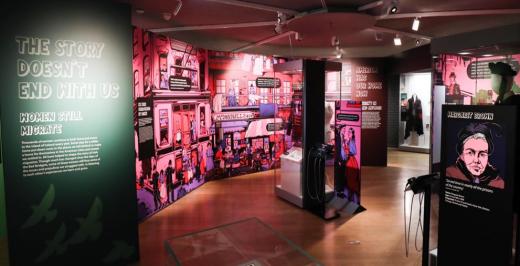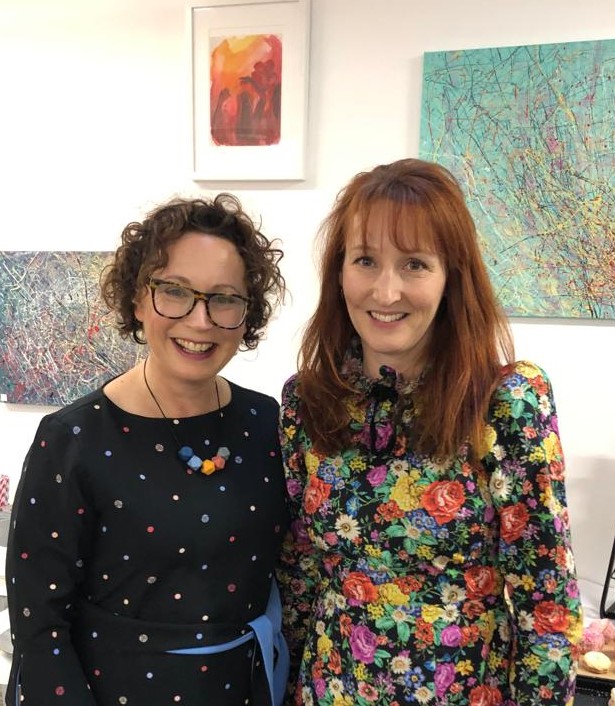
‘With a saturated colour palette and a focus on poor emigrant women who often found themselves on the wrong side of the law, Bad Bridget lets visitors know loud and clear she is not like other exhibitions’, Margaret Middleton wrote in a lovely review of the Bad Bridget exhibition at the Ulster American Folk Park in Omagh, County Tyrone. [1] This exhibition, a collaboration with National Museums NI, had quieter origins. As part of our Arts and Humanities Research Council (AHRC) grant (AH/M008649/1), which funded us to travel to North America to research the suspected criminal and deviant activities of Irish immigrants in the nineteenth and twentieth centuries, we promised to make a Bad Bridget documentary taster. Moya Neeson of Morrow Communications, who we commissioned to produce the taster, selected the beautiful Ulster Folk Museum in Cultra as the filming location, and we settled into Corradreenan Farmhouse for a few hours.
It was as a result of our trip to the museum that day that we were put in touch with National Museums NI’s research manager, Dave Tosh, who saw a potential link between our project and desires at the Ulster American Folk Park in Omagh to showcase a female, urban side of Irish migration. Within a few months we were having fortnightly meetings with Liam Corry, the Curator of Emigration at the Ulster American Folk Park, Andrew McDowell, the Design and Interpretation Manager at National Museums NI, and Victoria Millar, Senior Curator of History at National Museums NI. This fortnightly Wednesday morning meeting was a constant in the calendar through several Covid lockdowns and the idea for a Bad Bridget exhibition started to take shape. Since we hadn’t budgeted for an exhibition in our original funding bid, we applied for and were fortunate in securing Follow-on-Funding from the AHRC (AH/V011391/1).
The experience of being involved in a major museum exhibition was new to us. It was also a new departure for National Museums NI, being the first time that National Museums NI had displayed an exhibition that originated in academic research. We have been researching the lives of Irish criminal women since 2015. Individual stories are very important to us; as social historians we want to discover the lived realities for Irish immigrants in North America, and as women’s historians we are conscious of the need to showcase the experiences of girls and women who were in many ways ignored or forgotten. [2] There sometimes feels like a responsibility attached to working with the lives of the marginalised. It was thus nerve-wracking handing these stories to museum colleagues, hoping that they would appreciate the fragments of women’s lives that we had collected, the desperate conditions in which some Irish migrants found themselves, the humour, agency, resolve, and advancement strategies evident in the records. Would the resultant exhibition communicate the complexities of the stories and lives of these women? But we quickly realised that Liam, Victoria and Andrew ‘got’ the research. When making decisions on what objects to include or what themes to expand upon in the text, they were very careful to bring decisions back to the research. This in turn meant that we trusted their judgement and were more than happy to defer to their expertise when other decisions were needed.
Senior Curator of History Victoria Millar has explained: ‘In order to encourage a deeper emotional connection with the story we wanted to tell, we decided to adopt a multisensory approach, consisting of illustrations, sounds, and smells.’ [3] The Bad Bridget exhibition is quite the sensory experience! It had an excellent creative team who interpreted our research on Irish migrant women in wonderful ways: author Jan Carson wrote the text for the exhibition, graphic illustrator Fiona McDonnell designed the striking images, Tasha Marks of AVM Curiosities created the scents, and Franziska Schroeder and Catriona Gribben produced soundscapes to accompany actress voiceovers.

Every time we visit the exhibition we spot additional details in Fiona’s illustrations. But the ‘Farrell and McCormick’ shebeen has to be one of our favourite scenes!
This collaboration proved to be a lot of fun! We trawled photographs of objects from National Museums NI’s collections, we discussed every sentence of text, and we debated hats and ties and luggage. Particularly memorable were the online smell sessions with scent consultant Tasha Marks, who guided us through scent stick samples that she had sent us in the post. It quickly became apparent than one person’s choice for a scented candle could make another person nauseous (and not just because one of us was pregnant)! These sessions resulted in four smell stations in the exhibition, including a scent reminiscent of the fairground and another the malodour of tenement life, based on authorities’ investigations of child neglect cases.
An exhibition obviously cannot tell every story, in the same way that only a selection of case studies can be specifically mentioned in a book. But working with colleagues at National Museums NI, we selected six individual stories to showcase in more detail in the exhibition. Each of the six women has a character totem and listening post, where the visitor can see how they might have looked (thanks to Fiona McDonnell’s artistic abilities), and what they might have said (thanks to Jan Carson and the six wonderful actresses who loaned their voices to the featured monologues: Margaret Cronin, Bronagh Donaghey, Isabelle Martin, Carly McCullough, Lucy Rafferty and Maggie Villarini). Jan wrote the museum text in the first person, drawing the visitor further into the lives of those who had left Ireland.
The exhibition includes almost 150 objects, selected from the excellent collections held by National Museums NI. Victora Millar led on the shortlisting, guided by colleagues in Conservation and in Textiles. The objects add a richness and authenticity to the exhibition, and contrast with the more modern feel of the graphic illustrations.
The exhibition launched at Easter 2022 and will remain in situ until the end of 2025. Overall, the collaboration proved a wonderful experience for us (for us) and we are very proud of the resultant exhibition. In a recent article in Curator: the Museum Journal, Victoria described it as an ‘immensely rewarding experience’ and suggests that the exhibition provides ‘a more authentic and inclusive representation of the past’. [4] The visitor survey responses and comment card contributions have also been great to read thus far, and have shown how engaged visitors have been with the stories we have told. The survey responses also show that the exhibition has researched its target 15-30-year-old demographic! While this was a new way of working for both us and National Museums NI, we hope that it will lead to further creative collaborations with other academics.
And it’s not every day that our research ends up on the bus stop!
Notes
1. Margaret Middleton, ‘Crossing continents’, review of the Bad Bridget exhibition, in Museums Association, July 2023, p. 44.
2. Elaine Farrell and Leanne McCormick, Bad Bridget: crime, mayhem and the lives of Irish emigrant women (Dublin, 2023).
3. Victoria Millar, ‘Bad Bridget: an unexplored aspect of the Irish migration story’ in Curator: The Museum Journal (2024), p. 5.
4. Millar, ‘Bad Bridget, p. 7.


